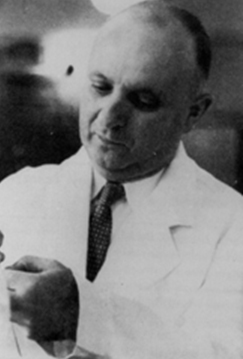 As the Perelman School of Medicine fast approaches its 250th birthday (to be celebrated next May), I’ve found it fascinating to look at how the school has changed -- and sometimes how its leaders have seemed to anticipate what lay ahead. Last month, the medical campus was visited by some members of the Class of 1964, returning for Medical Alumni Weekend and their 50-year reunion. In the Class of 1964’s yearbook, the Scope editors included a brief profile of the dean at that time, Samuel Gurin, PhD. Here’s part of what they said:
As the Perelman School of Medicine fast approaches its 250th birthday (to be celebrated next May), I’ve found it fascinating to look at how the school has changed -- and sometimes how its leaders have seemed to anticipate what lay ahead. Last month, the medical campus was visited by some members of the Class of 1964, returning for Medical Alumni Weekend and their 50-year reunion. In the Class of 1964’s yearbook, the Scope editors included a brief profile of the dean at that time, Samuel Gurin, PhD. Here’s part of what they said:
“His philosophy of medical education is based on the belief that today’s medical students must have a firmer grasp of the principles of both the basic sciences and of the methods of research in order to both compete in and to contribute to our medical world. As a means to this end, he is striving to make possib le for the students better lecture rooms and laboratories, more and better research facilities.”
Fifty years later, I suspect both Dean Gurin and the members of that class would be ecstatic -- and astonished -- to see where Penn’s current students have studied and worked. The campus has been transformed, by new facilities for both research and for patient care. Even more unexpected would be the Henry A. Jordan, M.D. ’62, Medical Education Center, atop the Perelman Center for Advanced Medicine, which will fully integrate medical education with research and clinical practice facilities.
Dean Gurin also had a chance to outline his views in the 1964 yearbook. A school like Penn’s, he wrote in “Perspectives in Medical Education,” should educate all medical students as if they were going to become a “research-oriented specialist” -- whether in patient-oriented research or in laboratory research. These days, the Perelman School is consistently ranked among the top five research-oriented medical schools by U.S. News & World Report. At the same time, however, this year it also ranked #13 among schools focused on primary care, which is a notable achievement.
Given that Gurin was the only dean of the medical school who was not an MD, his emphasis on research may not be surprising. But in his comments, Gurin makes it clear that the clinical part of education is just as important. “Whatever the specialty, the school should provide the educational background to bring the best of bio-medical science to the bed-side without losing sight of the fact that the patient is a human being and not just a disease.”
What I found notable is how closely Dean Gurin’s vision in some ways anticipated the major changes happening in medicine today. Back when the Class of 1964 attended our school, there was no program like the flourishing Biomedical Graduate Studies (BGS), which brings together faculty from basic science departments throughout the University, but there were some signs pointing that way. Gurin noted what he called “the scientific revolution” taking place in the early 1960s. The changes included “the breakdown of departmental barriers” as different departments simultaneously investigate different facets of the same problem, such as immunology, viral diseases, and metabolic diseases.
That complementary approach has continued in dramatic fashion. Today’s students were educated on a campus that includes the Penn Institute for Immunology, an Immunology Graduate Group within BGS, the Institute for Diabetes, Obesity, and Metabolism, a Division of Infectious Diseases in the Department of Medicine, and a virology component of the Department of Microbiology, to name just a few. For many years now, the Perelman School has been known for its many interdepartmental centers and institutes – and new ones have been added in recent years.
Could Dean Gurin even imagine the recently launched Center for Personalized Diagnostics, where patients’ tumors are probed more precisely with next-generation DNA sequencing? Those specialized tests are expected to broaden treatment options for patients with cancer and improve their efficacy.
Another fascinating bit is Dean Gurin’s recommendation that -- if time can be carved out of the students’ busy schedules -- they might choose to “study intensively in depth in any field.” His examples include biology, psychology, sociology, even mathematics. This view anticipates the dramatic changes over the last decade at Penn Medicine, as more and more students have earned a second degree or certificate or taken time off to do research or study abroad. In May, more than half of the graduating class received more than the MD degree. That’s a remarkable figure, because the average among graduating medical students across the nation is 8 percent.
Perhaps Dean Gurin’s receptivity to extra or outside pursuits can be traced in part to his own background.
He was a distinguished biochemist noted for his research on vitamin B and for his pioneering used of the radioactive C-14 in metabolic tracer studies. In 1955, he was named the Benjamin Rush Professor of Biological Chemistry and began a seven-year stint as chair of the Department of Biochemistry. In addition, however, he was a serious musician who had studied at Manhattan’s Juilliard School. According to his obituary in The Philadelphia Inquirer, his wife said he gave up his dream of being a concert pianist when he found he would have to practice eight hours a day! But he would also perform as a pianist at his home in Maine and he composed some orchestral music. Dean, chairman, scientist, teacher, musician -- he was, it appears, an example of the well-rounded person.